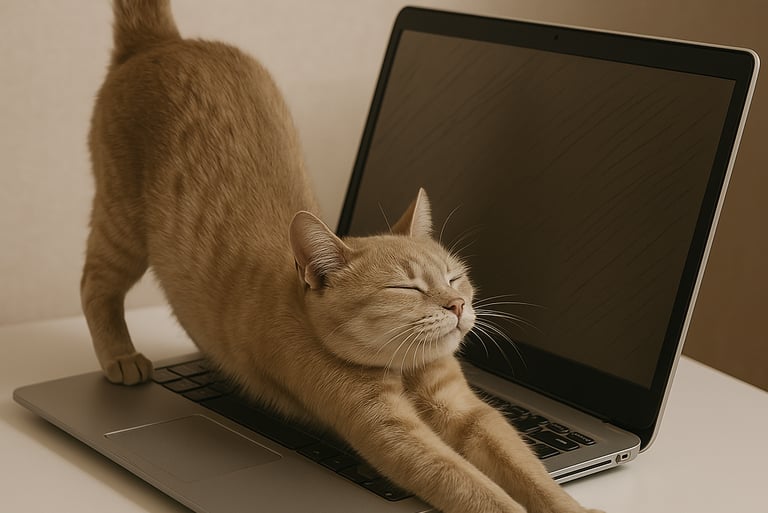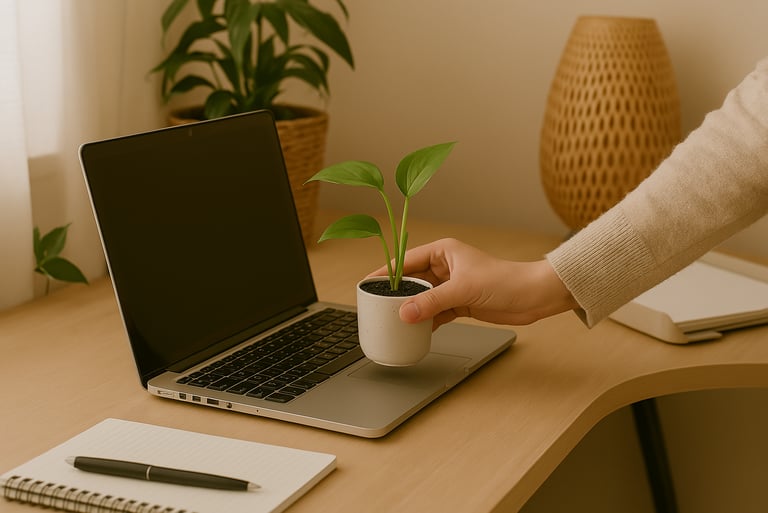How to create a wellness-focused home office
In this blog, we share practical tips for creating a wellness-focused home office that will help you stay energized, focused, and productive while working from home.
DECORWELLNESS


If you're working from home and still sitting half-twisted on the edge of your bed with a laptop overheating your thighs, you already know that this isn’t sustainable. It might start innocently: “Just for today,” you say.
Then weeks go by and your spine starts holding grudges.
Working from home can be good, quiet, flexible, no dress code. But if your space feels wrong, your brain follows. You get sluggish. Anxious. Your focus drops and your coffee intake triples.
So let’s fix that, yeah? Let’s make your space something that holds you up instead of quietly breaking you down.
This post may contain affiliate links and I may receive a commission for purchases made through links.
Step One: Pick Somewhere That Doesn’t Make You Want to Cry


You don’t need a whole room. You just need a spot that doesn’t make you feel boxed in or annoyed five minutes after sitting down. Somewhere with a bit of light (window light if you’re lucky) or a lamp that doesn’t hum if you’re not.
The point isn’t square footage. It’s vibe. Somewhere away from the chaos, or at least slightly buffered. Not smack in the kitchen while kids are raiding snacks, not under the TV. If your house or abode is tiny, steal a corner, a nook, a closet even. Toss up a curtain, drag over a plant, use a bookshelf as a makeshift wall. Whatever helps your brain say, this part of the house is for work.
You want to be able to walk away when you’re done. That’s half the battle right there.
Step Two: Get Rid of the Junk That’s Stressing You Out


Nobody works well surrounded by random receipts, tangled cords, or mystery crumbs. Doesn’t mean your space has to be spotless, just... less chaotic.
Go through your desk, shelf, wherever you’re stashing junk. Toss what you don’t use. Relocate what doesn’t belong. Keep what you need in reach, but make it feel nice. Use a tin for your pens. A shoebox for tech clutter. Maybe one of those carts with wheels, if you’re feeling fancy.
You don’t need a Pinterest board. You just need to not feel irritated every time you sit down. If your workspace makes you breathe easier instead of clenching your jaw, then you're on the right track.
Step Three: Sit Like You Plan to Survive This Job


You wouldn’t hike in flip-flops, so don’t work an eight-hour day in a chair that feels like a punishment. You need back support, plain and simple. Now that doesn’t mean spending $1500 on ergonomic nirvana, just something that keeps your spine from filing complaints.
Laptops? They’re great until your neck’s locked up. Raise the screen. Add a separate keyboard and mouse. Use a stack of cookbooks if you must. Ergonomic isn’t about looking cool, it’s about avoiding slow, creeping doom in your joints.
Step Four: Make It Work Like You Do


Your system doesn’t have to be pretty. It just has to keep you sane. That could be a whiteboard covered in scribbles or a planner with colour-coded stickers, whatever actually helps you show up and get things done without muttering curse words under your breath.
Keep the stuff you use every day where your arms can reach it. The rest can go in drawers, boxes, or a basket you swear you’ll sort eventually. What matters is this: when work starts, you know where your tools are, and they’re not buried under last week’s receipts.
Step Five: Give the Room a Pulse


Offices can feel like storage units for humans if you’re not careful. The fix? Add something alive. A plant, for starters. Snake plants are basically unkillable (nearly), pothos grow like they’ve got somewhere to be, and peace lilies will let you know when they’re thirsty without drama.
Wood helps too. Could be your desk, a little stool, or even just a wooden pencil holder. Bonus points if you mix in soft textures, rugs, blankets, whatever makes the place feel like someone lives there and not like it’s waiting for a real estate showing.
A few natural touches, and suddenly it’s not just a workspace. It’s your space.
Step Six: The Chair Isn’t a Trap


You don’t need to be glued down to be productive. In fact, the longer you sit still, the more your body turns on you. You stiffen. Your brain fogs. Your neck develops opinions. It’s not laziness to move, it’s survival.
Every hour or so, just stand up. Doesn’t need to be dramatic. A stretch. A shuffle to the window. Maybe crack your back on the doorframe and sigh like a ghost in a Jane Austen novel. Five minutes. That’s it. Walk the hallway, breathe something other than screen glow. Your body will thank you. And maybe your brain, too.
Set a timer if your day disappears fast. Put “move” on a sticky note. Make it weird if you have to, just don’t go hours forgetting you’ve got legs.
Step Seven: It’s Never Really ‘Done’


You don’t marry your home office. You date it. And you’re allowed to change your mind.
What worked last month might feel stale next week. Maybe the lighting’s off, maybe the chair creaks, maybe the vibe’s just...off. That’s your cue. Shift a lamp. Swap a chair cushion. Try rearranging your desk like it’s furniture therapy.
Don’t wait for it to get unbearable. Notice the little irritations and fix them before they multiply. This space is supposed to help you, not slowly gnaw at your sanity.
Pay attention. Self-audit. Adapt.
The Last Bit: Make It Yours, Then Keep Making It Yours


Forget perfect. This isn’t Instagram. This is your day-to-day, hour-to-hour, back-to-back meeting survival space. It should work with you, not against you.
Start with a spot that feels tolerable, then coax it toward comfort. Plants, maybe. A lamp that doesn’t hum. A chair that doesn’t feel like medieval punishment. You’ll know what helps. And when something stops helping, don’t just sit and suffer, change it!
Your home office is allowed to evolve. So are you.
If it feels even a little bit better at the end of the day than it did at the start, that’s a win.
